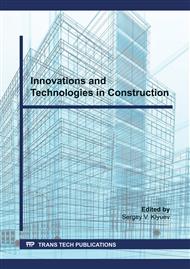[1]
Kezdi, Stabilized earth roads, Elsevier, (2016).
Google Scholar
[2]
R. N. Yong, V. R. Ouhadi, Experimental study on instability of bases on natural and lime/cement-stabilized clayey soils, J. Applied clay science, 35(3-4) (2007) 238-249.
DOI: 10.1016/j.clay.2006.08.009
Google Scholar
[3]
K.S. Zagorodnykh, O.B. Kukina, Analysis of the clay soil stabilization problem (in Russian), J. Scientific bulletin of VGASU, 9(2015) 55-63.
Google Scholar
[4]
T.V. Dmitrieva, I.Yu. Markova, V.V. Strokova, A.A. Bezrodnykh, N.P. Kutsyna, Efficiency of stabilizers of various composition for strengthening the soil with a mineral binder (in Russian), Construction Materials and Products, 3(1) (2020) 30-38.
DOI: 10.34031/2618-7183-2020-3-1-30-38
Google Scholar
[5]
K.E. Voskanyants, Development of the compositions and technologies of the soils strengthening and stabilization for road construction (in Russian), J. Scientific research. 6 (2018) 23-25.
Google Scholar
[6]
A.I. Trautvain, A.E. Akimov, V.B. Chernogil, Study of physical and mechanical characteristics of various types of soil strengthened by clinker waste (in Russian), Construction Materials and Products, 1(3) (2018) 43–50.
DOI: 10.34031/2618-7183-2018-1-3-43-50
Google Scholar
[7]
T.T. Abramova, A.I. Bosov, K.E. Valieva, Use of stabilizers for improvement of cohesive soil properties (in Russian), J. Geotechnika, 3 (2012) 4-28.
Google Scholar
[8]
L. Chen, D. F. Lin, Stabilization treatment of soft subgrade soil by sewage sludge ash and cement, Journal of Hazardous Materials, 162 (1) (2009) 321-327.
DOI: 10.1016/j.jhazmat.2008.05.060
Google Scholar
[9]
A.I. Trautvain, A.E. Akimov, E.A. Yakovlev, Improvement of Properties of the Argillaceous Soils When Using Additives Chimston, in Combination with Inorganic Astringent, Materials Science Forum, 945 (2019) 136-140. A. J. Puppala et al., Studies on sulfate-resistant cement stabilization methods to address sulfate-induced soil heave, Journal of geotechnical and geoenvironmental engineering, 130(4) (2004) 391-402. B. S. Narendra et al., Prediction of unconfined compressive strength of soft grounds using computational intelligence techniques: a comparative study, Computers and Geotechnics, 33(3) (2006) 196-208.
DOI: 10.4028/www.scientific.net/msf.945.136
Google Scholar
[10]
A.A. Fedulov, The use of surfactants (stabilizers) to improve the properties of cohesive soils in road construction (in Russian), Dissertation of the candidate of technical sciences, MADGTU (MADI), Moscow, (2005).
Google Scholar
[11]
R.G. Kochetkova, Efficiency of using new generation stabilizers (in Russian), Roads of Russia. 5(2014) 65-72.
Google Scholar
[12]
S.V. Karatsupa, E.A. Yakovlev, T.V. Dmitrieva, Strengthening clay rocks in road construction (in Russian), Bulletin of BSTU named after VG. Shukhov, 3 (2008) 12-15.
Google Scholar
[13]
S. Sannikov et al., The appliance of prefabricated soil-cement slabs processed with a hydrophobizing material for the road construction, MATEC Web of Conferences – EDP Sciences, 196 (2018) 04026.
DOI: 10.1051/matecconf/201819604026
Google Scholar
[14]
M. Çullu, M. Arslan, The effects of chemical attacks on physical and mechanical properties of concrete produced under cold weather conditions, Construction and Building Mater. 57 (2014) 53–60. A. A. Ramazanov et al., Soil-concrete in the foundation laying (in Russian), Construc. Uniq. Build. Struct, 3(30) (2015) 111-128.
DOI: 10.1016/j.conbuildmat.2014.01.072
Google Scholar
[15]
N. Xie, Yu. Dang, X. Shi, New insights into how MgCl2 deteriorates Portland cement concrete, Cement and Concrete Res. 120 (2019) 244–55.
DOI: 10.1016/j.cemconres.2019.03.026
Google Scholar
[16]
K. Onyelowe et al., Rheology of mechanical properties of soft soil and stabilization protocols in the developing countries-Nigeria, Materials Science for Energy Technologies, 2(1) (2019) 8-14.
DOI: 10.1016/j.mset.2018.10.001
Google Scholar
[17]
K.C. Onyelowe, I.C. Onuoha, Ordinary portland cement stabilization of amaoba-umuahia lateritic soil using snail shell ash, SSA as admixture, Int. J. Innovative Stud. Sci. Eng. Technol, 2(1) (2016) 356-361.
Google Scholar
[18]
F. Škvára, T. Jílek, L. Kopecký, Geopolymer materials based on fly ash, Ceram.-Silik, 49(3) (2005) 195-204.
Google Scholar
[19]
E. A.Vdovin, V. F. Stroganov, Optimization of complex frost-resisting additives in line with operational requirements towards freezing temperature in road dressing constructions, IOP Conference Series: Materials Science and Engineering, 832(1) (2020) 012034.
DOI: 10.1088/1757-899x/832/1/012034
Google Scholar
[20]
T.T. Abood, A.B. Kasa, Z.B. Chik, Stabilization of silty clay soil using chloride compounds, JEST Malaysia, 2(2007) 102-103.
Google Scholar
[21]
R. Demirboğa, F. Karagöl, R. Polat, M. A. Kaygusuz, The effects of urea on strength gaining of fresh concrete under the cold weather conditions, Construction and Building Mater, 64 (2014) 114–120.
DOI: 10.1016/j.conbuildmat.2014.04.008
Google Scholar


